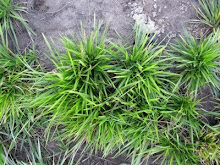Wednesday, 5 May 2010
Turbo-charged grasses
Life on Earth would not work without photosynthesis - the process used by green plants to convert atmospheric carbon dioxide and water into sugars. Almost all of the living things (with a few exceptions in the deep sea) depend on this process to grow and survive - plants use photosynthesis directly as a source of energy and the building blocks for growth. Animals consume plants (and each other) to acquire the same resources for life. Humans are no exception - we eat crops and animals that are raised on plants and, to a large extent, these plants are grasses (comprising more than 50% of our calorie intake).
Most of the world's plant species use a basic model of photosynthesis, called the C3 pathway. But around 4% have an upgraded form called C4 photosynthesis. Among grasses, the usage of this pathway is much more common, with about half of the world's grasses using C4 photosynthesis. Plants with the C4 photosynthetic pathway rank among the world's most important crops and noxious weeds. Maize, Sorghum and Millet are staple foods throughout the tropics, Sugarcane is traded globally, and 14 out of the world's 18 worst weeds are C4 plants.
The C4 pathway is a fuel injection system for photosynthesis that increases the rate of sugar production in hot climates by overcoming an inefficiency of the C3 type arising at high temperatures. It is an add-on to the regular C3 pathway. In the leaf of a C4 plant, the C3 pathway is isolated from the atmosphere in a specialized cellular compartment. The C4 cycle pumps carbon dioxide into this compartment to saturate the C3 photosynthetic enzymes, allowing them to operate super-efficiently, and at high rates. It is no coincidence that the most productive plants on Earth are C4 grasses.
More details on how the process works
GrasPortal should help us to better understand how C4 photosynthesis has evolved in grasses. We already know that the pathway has evolved at least eight times in this group (and probably more). As the evolutionary relationships between grass species become better understood, this picture should become clearer. Recent work has also shown that open conditions (no shading from trees) are important for this evolutionary transition, and that the evolution of C4 photosynthesis has been crucial in allowing grasses to move into drier habitats. GrassPortal will aid the research in this area by allowing us to map the environmental preferences of each species onto the evolutionary tree of life. By doing this, it will help us to discover more about how the C4 pathway has evolved, and the new ecological opportunities it has brought for grasses.
Subscribe to:
Post Comments (Atom)




No comments:
Post a Comment